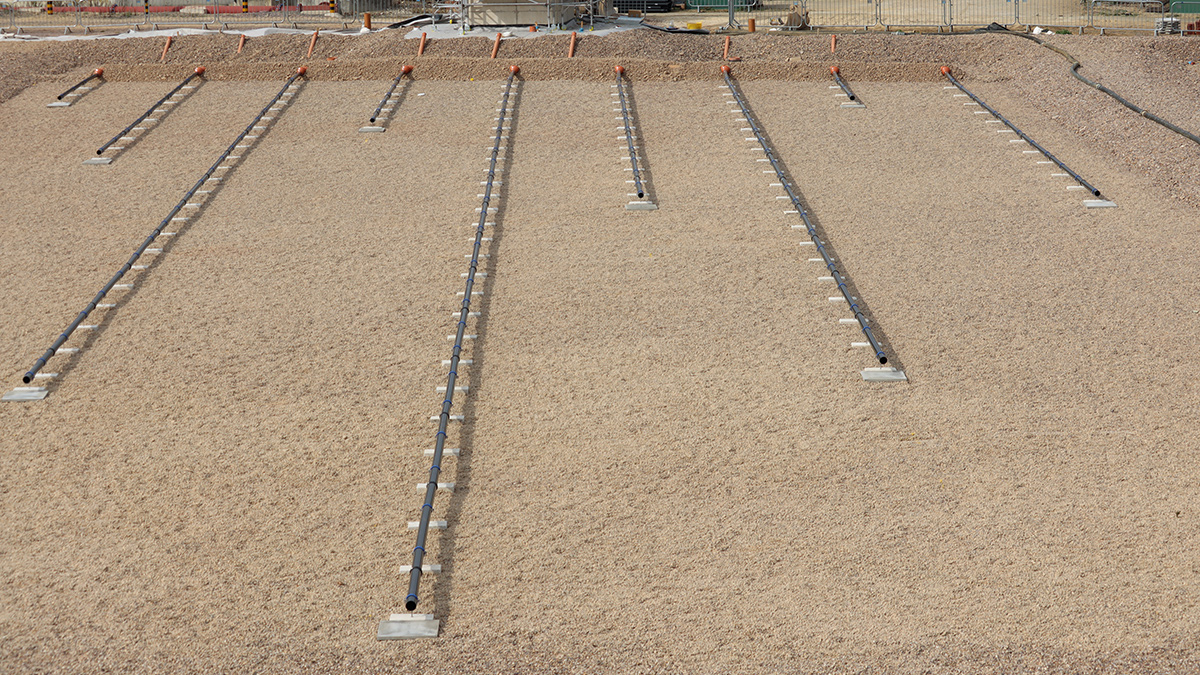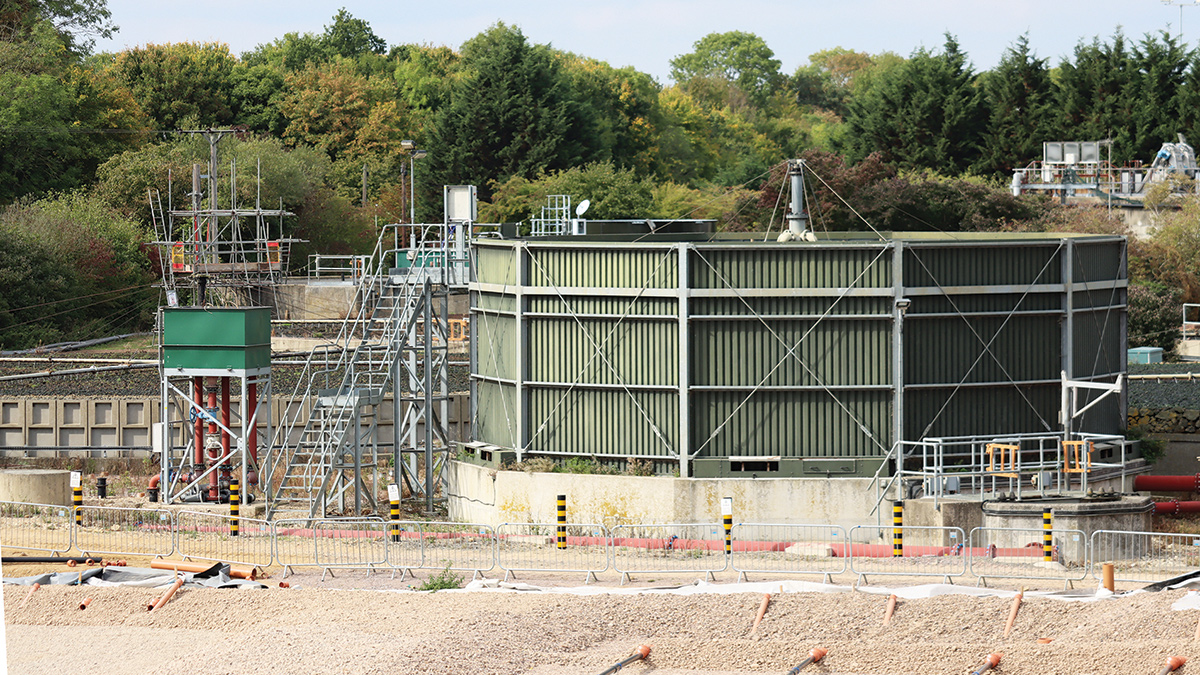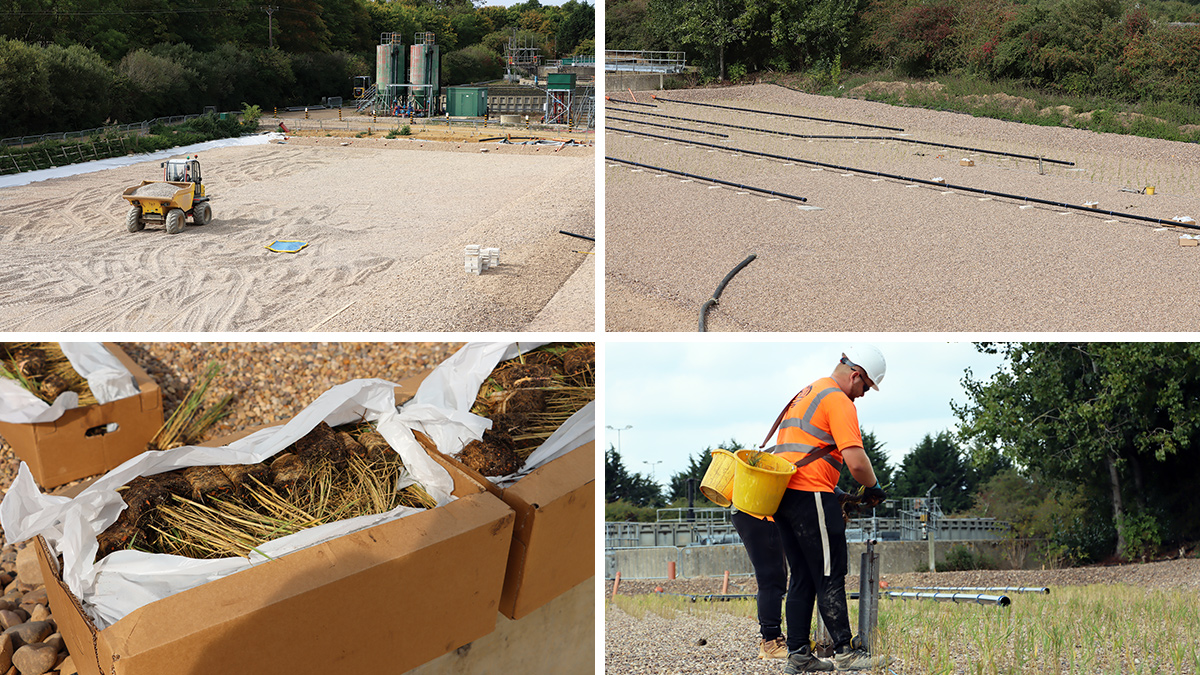Sleaford WRC (2024)

Aeration pipework for the Sleaford WRC reed bed - Courtesy of @one Alliance
Sleaford is a small market town in the North Kesteven district of Lincolnshire. The town is situated on the edge of the fenlands, 11 miles from Grantham and 17 miles south of Lincoln. Sleaford Water Recycling Centre is located just off the A17, north-east of the town. Anglian Water was required to meet a new full flow to treatment (FFT) obligation that the current system could not achieve, as it did not possess adequate hydraulic and biological treatment capacity or volume to comply with the new, higher FFT requirements. As a result, Anglian Water instructed the @one Alliance to put a solution in place to meet the new regulation which had an obligation date of March 2025.
Solution
The first proposed solution was to optimise the existing site with the introduction of an additional intermittently-used side stream, to achieve the increase flow from 119.5 l/s (10,327m3/d) to 160.2 l/s (13,845m3/d).
However, this solution was based on the PST/FST/sand filter which upon investigation, would have resulted in excessive costs and, due to the lack of space on site, would have been difficult to construct.
The Anglian Water @one Alliance was tasked with proposing a solution to meet the financial and operational requirements. As part of a ROV5 (risk | opportunity | value) meeting, the team decided on the reed bed solution. This solution included the removal of standby generators by utilising the new aerated reed beds to provide 4 hours of treatment capacity in case of power failure and the use of a pumping station. The scheme also including re-purposing the existing storm tank to remove the need for a new piled final settlement tank (FST), which resulted in the re-use of the current scraper bridge and its internals were maintained. The solution of the side-stream process of a primary sedimentation tank (PST) and aerated reed beds to treat the additional flow was taken forward as the DM1 strategy.
This solution at the design stage was adapted to deliver a new above-ground storm tank together with an additional side-stream process comprising a primary settlement tank and aerated reed beds in order to treat the additional FFT requirements of 40.7 l/s, plus return flows from the existing site, resulting in a total additional treatment of 55 l/s through the new side stream process.
This system will help the treatment works build resilience to extreme weather caused by climate change and will protect the local environment by helping reduce the use of storm overflows. The reed beds put in place will also use plants to naturally clean wastewater to help the environment.

Above-ground tricking filter – Courtesy of @one Alliance
New storm tank
By excavating and balancing the drainage and inlet connection pipework, an octagonal base was constructed and Hayes GFS Ltd installed a new 6m diameter storm tank.
Flow control
As part of the solution, the @one Alliance needed to interconnect with the existing works and the current flow control. The team utilised 150mm electromagnetic flow meters capable of 55 l/s located at the inlet works and 250/150mm pipework to connect to the inlet works. Adding supporting steelwork, local isolators and junction boxes were used to receive the power and signalling from the flow meter’s transmitter. This was then able to be connected to the aerated reed bed MCC from Paktronic Engineering Company Ltd.
Converting the existing storm tank to a PST
Early in the design phase it was realised that by converting the existing storm tank into the new primary settlement tank there would be a reduction in costs, programme time and the carbon impact.
This could be achieved by installing 250/150mm stainless steel pipework from the inlet works to the existing PST inlet chamber (former storm tank) above the ground. The new PST was completed with supporting auto-desludge pump skid, motor and 10m of pipe sitting on a 6m x 6m x 0.25m concrete slab.
Aerated reed bed
The team managed to refurbish the existing tertiary treatment reed beds and install three duty/duty/standby blowers. The reed beds were fully cleared of all prior material, with new liners installed followed by new gravel and aeration pipework to promote reed bed growth.
- By casting the new outlet wall in concrete and separating the FE chamber and the reed beds, the team managed to reshape the existing bases of the beds.
- By installing new weir plates, the reed beds could be fed from the humus tank outlet.
- By connecting the new PST to the reed beds with DN250 DI pipework 150m long with a range of buried sections we managed to connect the process up.
- A dry riser connection was provided for clean down abilities for Anglian Water in the future.
On completion of the construction phase, the team ensured weekly visual inspections of the reed beds and the water levels, then adjusted the control arm as necessary. They also ensured weeds were removed weekly whilst checking the blower intake filter, oil levels and blower belt guard to ensure the resource was in full working condition.
Moving forward, the team completed three monthly inspections of the valves’ flow to the directed reed beds to check that the outlet distribution ports were not blocked. This ensured an even spread of flow to the reed bed surface. This was checked by looking at the flow being collected in the level control chamber as this will give an indication if there are any blockages into the collection pipework.

(top left) Preparing the reed beds, (top right) aeration pipework for the reed bed, (bottom left) the reeds, prior to planting, and (bottom right) reed bed planting – Courtesy of @one Alliance
Sleaford WRC: Supply chain – key participants
- Design & project delivery: @one Alliance
- Civil engineering works: Bell Formwork Services Ltd
- Mechanical & electrical installation: Glasswell & Last
- Reed beds: ARM Ltd
- MCC kiosk: Morgan Marine
- MCC panels: Paktronic Engineering Company Ltd
- Storm tank: Hayes GFS Ltd
Challenges
Due to the residual impact of Covid-19 on the global supply chain in the summer of 2022, there was a 6-month delay in electronic hardware being delivered to site, despite this infrastructure being procured in advance. There were also delays with the civil engineering due to the congestion of existing services around the inlet works.
Conclusion
By re-purpose existing Anglian Water assets, the @one Alliance reduced the overall cost of the scheme, reduced carbon emissions and made the best use of limited space on site. This new aerated system will use the reeds to clean wastewater by utilising micro-organisms in the reed beds that break down, digest and clean the water so it can be safely returned to the natural environment; reducing the need for chemical dosing. Planning and design of this £4.1m project started in December 2021 and construction completed in March 2023.




